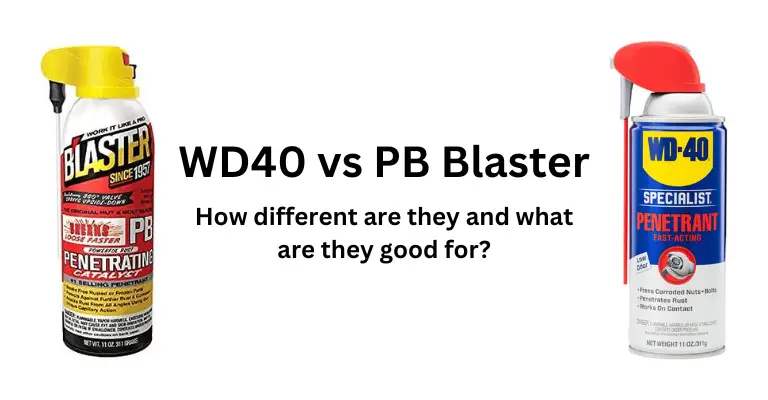- How to Clean Car Carpets Quickly (Without An Extractor) - July 10, 2024
- Can You Touch Up Clear Coat On A Car? Yes and No (Here’s Why) - November 25, 2023
- How To Wax A Car By Hand (For Beginners) - November 14, 2023
Last Updated on January 16, 2025 by Nate Schnell
In the world of lubricants and rust removers, two names often reign supreme: WD-40 and PB Blaster. Both have earned a reputation as reliable maintenance staples, but are they really the same? Or do they serve different purposes? Let’s dive into an in-depth comparison to help you understand their strengths, weaknesses, and the best scenarios for each.
What Is WD-40?
WD-40 has been a household name since the 1950s. The “WD” stands for “Water Displacement,” highlighting its primary function of repelling moisture. It’s made up of a blend of lubricants, corrosion inhibitors, and other proprietary ingredients designed for a wide range of tasks.
WD-40 is widely recognized for its versatility. It’s used for everything from loosening rusty bolts to cleaning grease and protecting metal parts from rust. This versatility makes it a staple in toolkits across the globe.
Strengths of WD-40
One of WD-40’s biggest advantages is how multi-functional it is. If you need to remove grime, displace moisture, or silence a squeaky hinge, WD-40 is your go-to. It’s affordable, easy to find, and can be used for household, automotive, and DIY projects.
Additionally, its application process is straightforward. The spray can design, often paired with a precision straw, allows you to target both large areas and tight spaces. Another benefit is its mild formula, which is safe on many surfaces, including metal, rubber, and plastic.
Weaknesses of WD-40
While WD-40 is versatile, it’s not always the best option for tougher jobs. Its lubrication properties are temporary, so you may find yourself reapplying it frequently for more demanding tasks. For instance, it struggles with extremely corroded parts, where a more specialized penetrating oil is necessary.
Common Uses for WD-40
- Loosening stuck bolts and hinges
- Removing grease and grime from engine parts
- Silencing squeaky door hinges and seat belt mechanisms
- Displacing water from electrical components
- Preventing short-term rust and corrosion
However, WD-40’s water-displacement feature means it’s better suited for preventive maintenance rather than deep rust penetration.
What Is PB Blaster?
PB Blaster entered the market in 1957 and quickly gained a reputation as a heavy-duty penetrating oil. Unlike WD-40, PB Blaster specializes in breaking free severely rusted or stuck components. Its formula is designed to seep into small crevices, dissolving rust and corrosion from within.
PB Blaster is often the preferred choice for mechanics and professionals who need something powerful enough to tackle rust-locked bolts, engine parts, and plumbing fixtures.
Strengths of PB Blaster
PB Blaster excels in scenarios where other lubricants fail. Its penetrating capabilities allow it to reach deeply into rusted parts, loosening them with ease. It also provides longer-lasting lubrication compared to WD-40, making it ideal for applications that require durable protection.
Another notable feature is its ability to continue working even after application. PB Blaster leaves behind a film that protects the metal from future rusting and corrosion.
Weaknesses of PB Blaster
One of the main drawbacks of PB Blaster is its strong odor. The fumes can be overwhelming, especially in enclosed spaces. Additionally, it’s highly flammable, so extra caution is needed when using it near heat or open flames.
PB Blaster is also less versatile than WD-40—it’s not designed for cleaning tasks or water displacement. Its primary purpose is to break through tough rust and provide long-lasting lubrication.
Common Uses for PB Blaster
- Freeing rusted bolts, nuts, and screws
- Loosening stuck car parts like brake calipers and exhaust bolts
- Preventing rust after repairs
- Industrial maintenance tasks
If you’re dealing with corroded parts that refuse to budge, PB Blaster is the tool you need.
WD-40 vs. PB Blaster: Key Comparisons
Let’s take a closer look at how these two products differ in terms of performance and use cases:
Versatility
WD-40 wins in terms of versatility. It’s a multi-purpose product that can handle cleaning, lubricating, and rust prevention in everyday situations. PB Blaster, on the other hand, is more specialized and excels specifically at penetrating rust and loosening stuck parts.
Rust Removal
When it comes to breaking free rusted bolts and stuck parts, PB Blaster takes the crown. Its penetrating formula is designed for heavy-duty rust removal. While WD-40 can help with minor rust issues, it doesn’t have the same penetrating power.
Lubrication
WD-40 provides temporary lubrication, making it great for quick fixes. PB Blaster offers longer-lasting lubrication, reducing the need for frequent reapplications.
Safety
WD-40 is generally considered safer to use due to its milder formula and less pungent smell. PB Blaster, however, requires caution due to its strong fumes and flammable ingredients.
When to Use WD-40
Use WD-40 when you need a quick, all-around solution for:
- Preventing rust on exposed metal parts
- Displacing moisture from electrical systems
- Silencing squeaky hinges and pulleys
- Cleaning off grease and adhesive residue
When to Use PB Blaster
PB Blaster is your best bet for:
- Freeing rust-locked bolts and fasteners
- Heavy-duty automotive or industrial repairs
- Protecting components after repairs in high-moisture environments
Final Verdict
The choice between WD-40 and PB Blaster depends on your needs. If you’re looking for a versatile, everyday lubricant and cleaner, WD-40 is the better option. It’s perfect for quick fixes and preventive maintenance. However, if you’re dealing with stubborn rust and need something powerful enough to break through heavy corrosion, PB Blaster is the clear winner.
Both products have earned their place in toolboxes for a reason. WD-40 offers convenience and versatility, while PB Blaster excels in raw penetrating power. By understanding their differences, you can choose the right tool for the job and get the best results every time.



